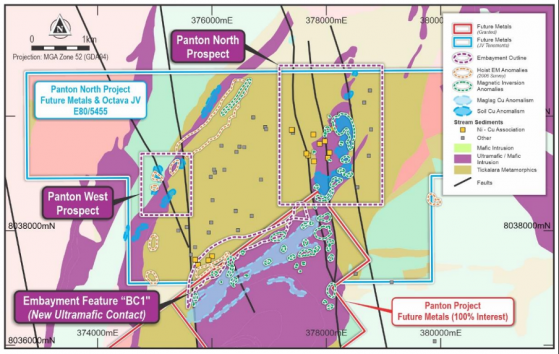Street Calls of the Week
In an exciting development for its nickel, copper and platinum group metal (PGM) targets, Future Metals NL (ASX:FME, AIM:FME) has kicked off 2,000 metres of reverse circulation (RC) drilling at its Panton North property in WA.
The polymetallic exploration play — covered under a farm-in agreement with Octava Minerals Ltd (ASX:OCT) — neighbours FME's cornerstone Panton PGM-nickel camp, just 60 kilometres north of Halls Creek in the tier-one eastern Kimberley region.
Future Metals plans to hit the ground running at Panton North’s BC1 and Panton West prospects, where it’ll test for base and platinum group metals across a suite of prospective anomalies.
In a financial boost, the Western Australian State Government has provided A$147,000 in EIS funding to co-fund drilling at the Panton West prospect.
Panton and Panton North exploration targets.
Let the drilling commence
This RC program follows a prolonged campaign out in the field, where Future analysed electromagnetics, gravity surveys, stream sediments, soil and rock chip samples to prove up its drill target portfolio.
The BC1 prospect is the first to pass under the drill bit, with an RC program specifically designed to test the newly interpreted basal contact for the Panton sill.
Subsequently, at Panton West, Future is targeting unique magnetic features that coincide with electromagnetic anomalism at depth.
These elements are situated on the contact of a gravity high, interpreted to be an ultramafic intrusion under cover.
Neither of these targets have been drilled previously, so Future is excited to see what the rig turns up as it works through to early July.
Why PGMs?
Amid the push for cleaner, greener energy technologies, much of the world is focused on critical minerals like lithium, nickel and rare earths.
But Future Metals believes platinum group metals — a collection comprising platinum, palladium, iridium, osmium, rhodium and ruthenium — are just as important in the move towards a carbon-neutral future.
Exceptionally rare, PGMs have similar physical and chemical properties and tend to occur, in varying proportions, together in the same geological deposit.
Their utility is characterised by unique chemical and physical properties, making them desirable minerals in a wide range of modern applications.
You’ll often see PGMs used as auto-catalysts (pollution control devices for gas-powered vehicles), but they’re also used in jewellery, electronics, hydrogen production/purification and hydrogen fuel cells.
Simply put, PGMs can help convert harmful exhaust pollutants into harmless compounds, thereby improving air quality and reducing emissions — an impressive rap sheet as the world moves to carbon neutrality.
